Taxation Law Assignment: Analyzing FBT, CGT & Income Tax Law
VerifiedAdded on 2023/04/03
|9
|2390
|91
Report
AI Summary
This assignment solution delves into various aspects of taxation law, primarily focusing on fringe benefit tax (FBT) and capital gains tax (CGT). It addresses the tax liability of fringe benefits provided by an employer to an employee, specifically examining a case involving a company car and the application of both the statutory formula method and the operating cost (log book) method for calculating taxable value. The analysis concludes that the statutory method is more suitable in the given scenario due to a lower tax payable value. Furthermore, the assignment explores capital gains tax implications related to the sale of different assets, including a house, a painting, a luxury yacht, and shares, identifying relevant CGT events and calculating net capital gains. The solution references relevant sections of the ITAA 1997 to support its analysis and computations. Desklib offers a range of similar solved assignments and past papers for students seeking assistance with their studies.
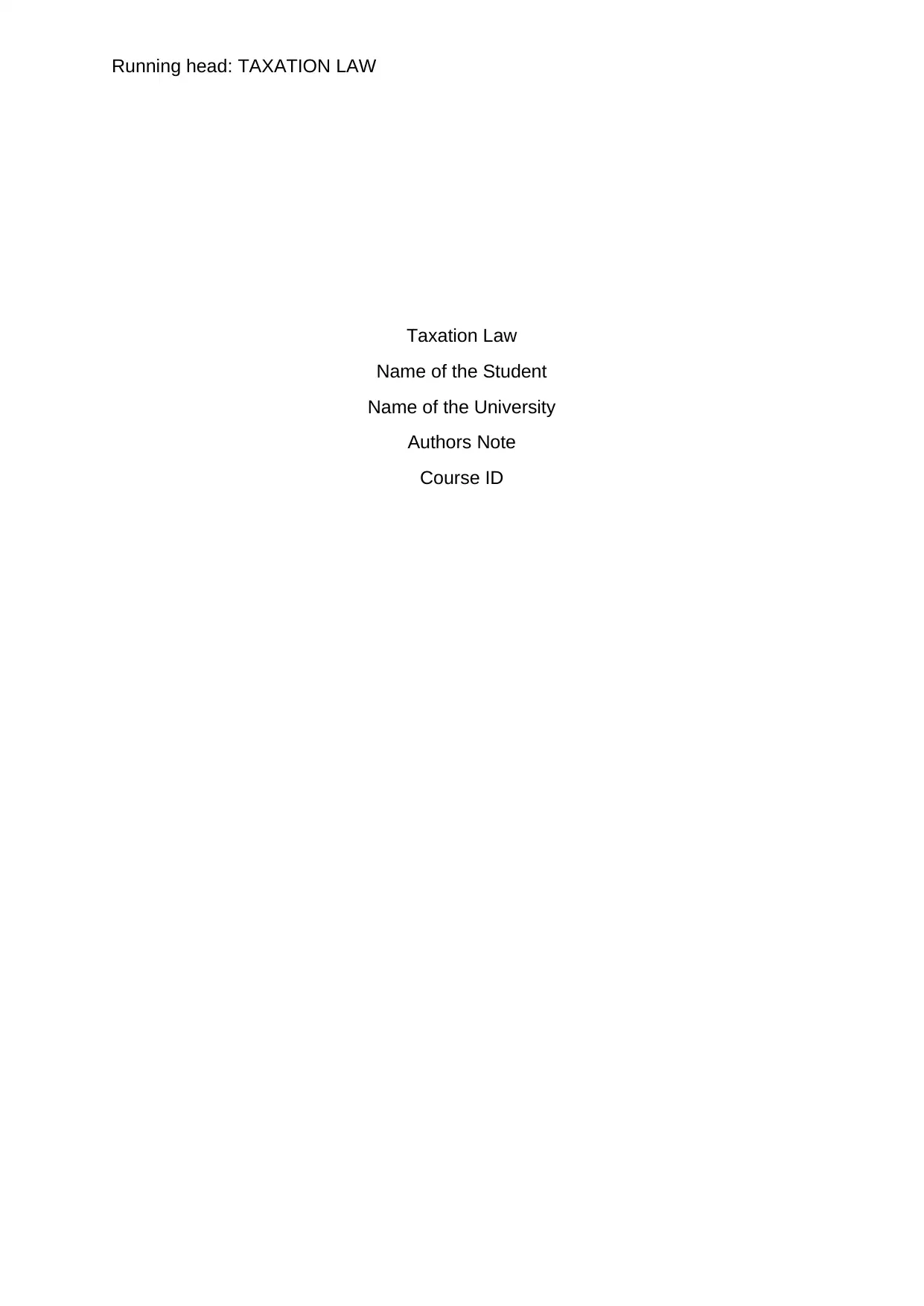
Running head: TAXATION LAW
Taxation Law
Name of the Student
Name of the University
Authors Note
Course ID
Taxation Law
Name of the Student
Name of the University
Authors Note
Course ID
Paraphrase This Document
Need a fresh take? Get an instant paraphrase of this document with our AI Paraphraser
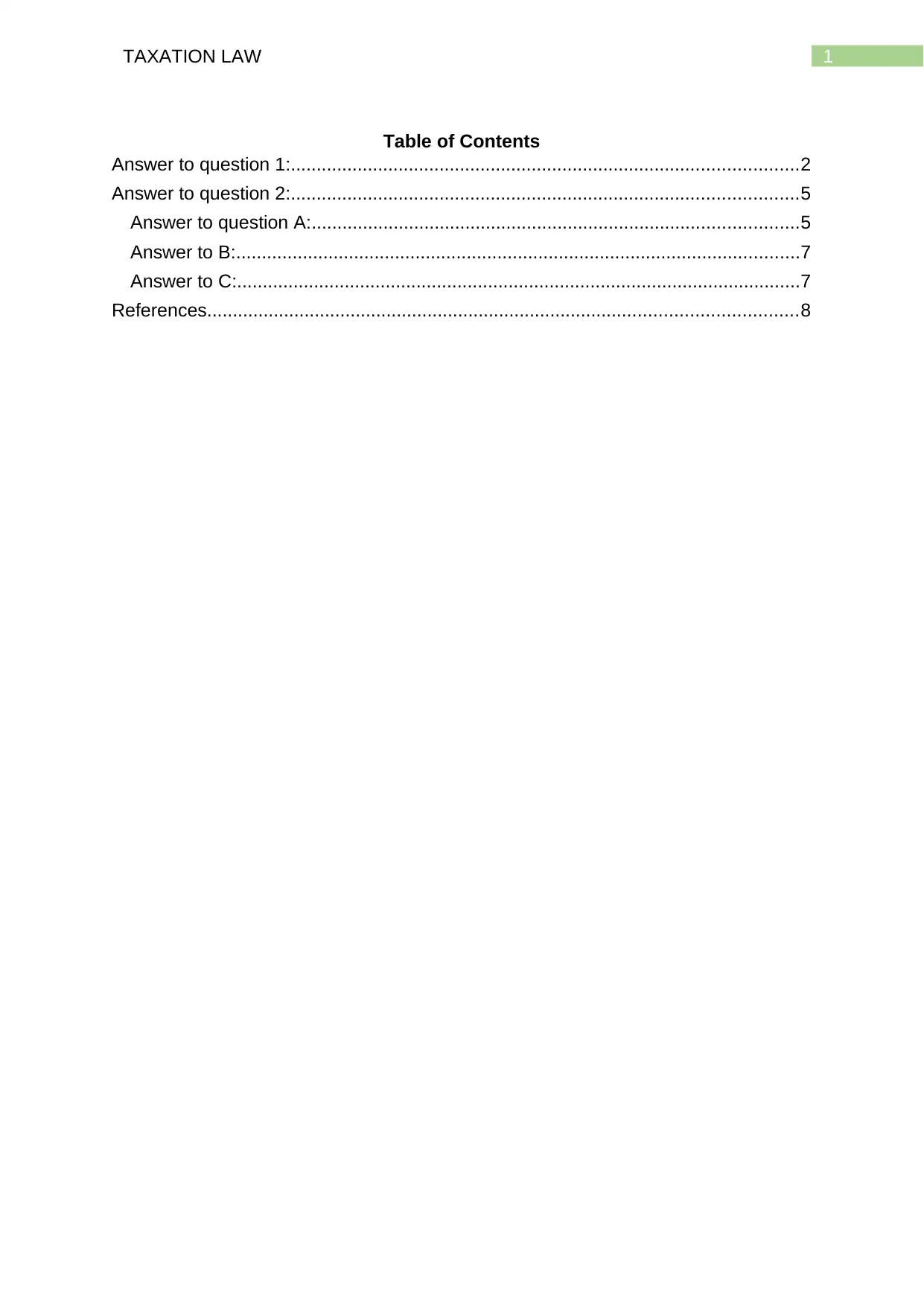
1TAXATION LAW
Table of Contents
Answer to question 1:...................................................................................................2
Answer to question 2:...................................................................................................5
Answer to question A:...............................................................................................5
Answer to B:..............................................................................................................7
Answer to C:..............................................................................................................7
References...................................................................................................................8
Table of Contents
Answer to question 1:...................................................................................................2
Answer to question 2:...................................................................................................5
Answer to question A:...............................................................................................5
Answer to B:..............................................................................................................7
Answer to C:..............................................................................................................7
References...................................................................................................................8

2TAXATION LAW
Answer to question 1:
Issues:
The current issue that is surrounding this case is the tax liability of the fringe
benefits provided by the employer to the employee in relation to the employment.
Rule:
Fringe benefit should be noted as the payment that is given to the employee
but it is not the same as the salary or the wages. As explained in the legislation of
the FBT, a fringe benefit should be viewed as the benefit that is given to employee in
discharge of his employment relationship. This eventually means under “section
136 (1), FBTAA 1986” the benefit that is provided to the employee since they are
the employee (Hodgson and Pearce 2015). Under the fringe benefit tax, the
employer is accountable for the fringe benefit tax if the employer makes the payment
to the employee, director of the company or the office holder that will be subject to
withholding obligations or if the benefits provided to the employee in respect of such
payments.
As the employer, they are required to pay the fringe benefit tax
notwithstanding of whether they are the sole trader, trustee, partnership or the
government authority. It is irrespective of whether the employer or the another party
provides the fringe benefit. The fringe benefit tax is payable whether or not the
employer is liable for paying other taxes particularly the income tax (Pearce and
Hodgson 2015). The employer can claim the income tax deduction for the cost of
offering benefit and for the amount of fringe benefit tax they pay.
As explained in the “section 7 (1), FBTAA 1986” a car fringe benefit
happens when the employer makes the available for the employee’s private use. An
employer makes the car available for their private use by the employee on any given
day if the car is generally used for the employee’s private purpose by the employee
or making the car available for their private use of the employee. As the general rule,
traveling from home to the work place is regarded as the private use of the car.
To calculate the taxable value of the car fringe benefit there are two methods.
This namely includes the statutory formula method and the operating cost method. A
taxpayer is mandatorily required to choose the statutory formula unless they elect to
make use of the operating cost methods (Braverman, Marsden and Sadiq 2015).
The taxpayer might elect to select the operating cost method for any or for all the
cars, notwithstanding which method they used in the earlier year. As per section 7
(8) of the FBTAA 1986 in order to use the operating cost method it is necessary to
use the log book for keeping records.
Application:
In application of the above stated rules it is noted that Spiceco Pty Ltd gave
his employer Lucinda with the car for making their private use. All through the FBT
year of 2018/19 the car was made available to the Lucinda for her private use. It can
be stated that the car was provided to Lucinda in respect of the employment with the
Spiceco Pty Ltd. With respect to “section 136 (1), FBTAA 1986” the benefit was
provided to Lucinda during the year of taxation by her employer in relation to the
employment (Young and Miles 2015).
Answer to question 1:
Issues:
The current issue that is surrounding this case is the tax liability of the fringe
benefits provided by the employer to the employee in relation to the employment.
Rule:
Fringe benefit should be noted as the payment that is given to the employee
but it is not the same as the salary or the wages. As explained in the legislation of
the FBT, a fringe benefit should be viewed as the benefit that is given to employee in
discharge of his employment relationship. This eventually means under “section
136 (1), FBTAA 1986” the benefit that is provided to the employee since they are
the employee (Hodgson and Pearce 2015). Under the fringe benefit tax, the
employer is accountable for the fringe benefit tax if the employer makes the payment
to the employee, director of the company or the office holder that will be subject to
withholding obligations or if the benefits provided to the employee in respect of such
payments.
As the employer, they are required to pay the fringe benefit tax
notwithstanding of whether they are the sole trader, trustee, partnership or the
government authority. It is irrespective of whether the employer or the another party
provides the fringe benefit. The fringe benefit tax is payable whether or not the
employer is liable for paying other taxes particularly the income tax (Pearce and
Hodgson 2015). The employer can claim the income tax deduction for the cost of
offering benefit and for the amount of fringe benefit tax they pay.
As explained in the “section 7 (1), FBTAA 1986” a car fringe benefit
happens when the employer makes the available for the employee’s private use. An
employer makes the car available for their private use by the employee on any given
day if the car is generally used for the employee’s private purpose by the employee
or making the car available for their private use of the employee. As the general rule,
traveling from home to the work place is regarded as the private use of the car.
To calculate the taxable value of the car fringe benefit there are two methods.
This namely includes the statutory formula method and the operating cost method. A
taxpayer is mandatorily required to choose the statutory formula unless they elect to
make use of the operating cost methods (Braverman, Marsden and Sadiq 2015).
The taxpayer might elect to select the operating cost method for any or for all the
cars, notwithstanding which method they used in the earlier year. As per section 7
(8) of the FBTAA 1986 in order to use the operating cost method it is necessary to
use the log book for keeping records.
Application:
In application of the above stated rules it is noted that Spiceco Pty Ltd gave
his employer Lucinda with the car for making their private use. All through the FBT
year of 2018/19 the car was made available to the Lucinda for her private use. It can
be stated that the car was provided to Lucinda in respect of the employment with the
Spiceco Pty Ltd. With respect to “section 136 (1), FBTAA 1986” the benefit was
provided to Lucinda during the year of taxation by her employer in relation to the
employment (Young and Miles 2015).
⊘ This is a preview!⊘
Do you want full access?
Subscribe today to unlock all pages.

Trusted by 1+ million students worldwide
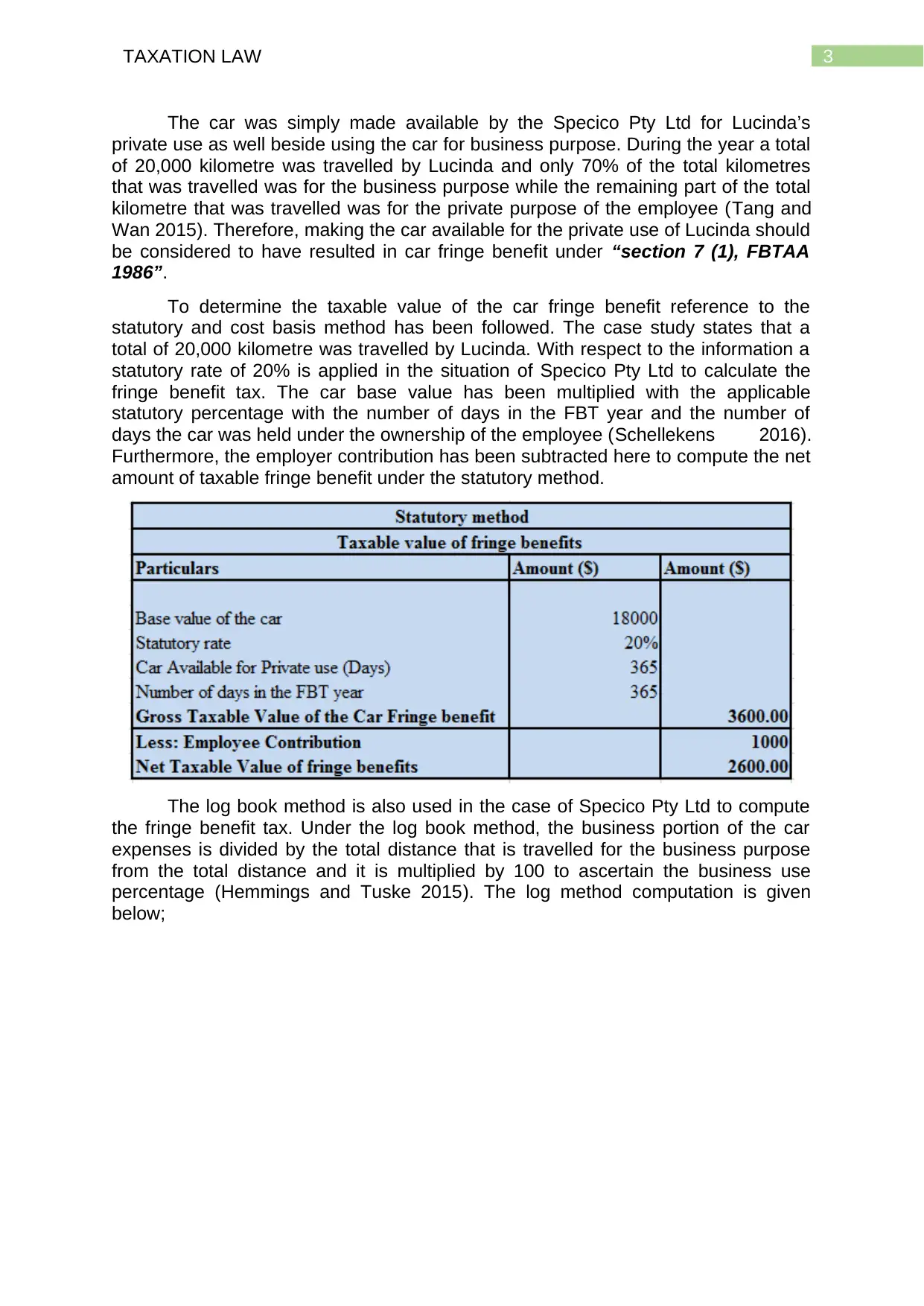
3TAXATION LAW
The car was simply made available by the Specico Pty Ltd for Lucinda’s
private use as well beside using the car for business purpose. During the year a total
of 20,000 kilometre was travelled by Lucinda and only 70% of the total kilometres
that was travelled was for the business purpose while the remaining part of the total
kilometre that was travelled was for the private purpose of the employee (Tang and
Wan 2015). Therefore, making the car available for the private use of Lucinda should
be considered to have resulted in car fringe benefit under “section 7 (1), FBTAA
1986”.
To determine the taxable value of the car fringe benefit reference to the
statutory and cost basis method has been followed. The case study states that a
total of 20,000 kilometre was travelled by Lucinda. With respect to the information a
statutory rate of 20% is applied in the situation of Specico Pty Ltd to calculate the
fringe benefit tax. The car base value has been multiplied with the applicable
statutory percentage with the number of days in the FBT year and the number of
days the car was held under the ownership of the employee (Schellekens 2016).
Furthermore, the employer contribution has been subtracted here to compute the net
amount of taxable fringe benefit under the statutory method.
The log book method is also used in the case of Specico Pty Ltd to compute
the fringe benefit tax. Under the log book method, the business portion of the car
expenses is divided by the total distance that is travelled for the business purpose
from the total distance and it is multiplied by 100 to ascertain the business use
percentage (Hemmings and Tuske 2015). The log method computation is given
below;
The car was simply made available by the Specico Pty Ltd for Lucinda’s
private use as well beside using the car for business purpose. During the year a total
of 20,000 kilometre was travelled by Lucinda and only 70% of the total kilometres
that was travelled was for the business purpose while the remaining part of the total
kilometre that was travelled was for the private purpose of the employee (Tang and
Wan 2015). Therefore, making the car available for the private use of Lucinda should
be considered to have resulted in car fringe benefit under “section 7 (1), FBTAA
1986”.
To determine the taxable value of the car fringe benefit reference to the
statutory and cost basis method has been followed. The case study states that a
total of 20,000 kilometre was travelled by Lucinda. With respect to the information a
statutory rate of 20% is applied in the situation of Specico Pty Ltd to calculate the
fringe benefit tax. The car base value has been multiplied with the applicable
statutory percentage with the number of days in the FBT year and the number of
days the car was held under the ownership of the employee (Schellekens 2016).
Furthermore, the employer contribution has been subtracted here to compute the net
amount of taxable fringe benefit under the statutory method.
The log book method is also used in the case of Specico Pty Ltd to compute
the fringe benefit tax. Under the log book method, the business portion of the car
expenses is divided by the total distance that is travelled for the business purpose
from the total distance and it is multiplied by 100 to ascertain the business use
percentage (Hemmings and Tuske 2015). The log method computation is given
below;
Paraphrase This Document
Need a fresh take? Get an instant paraphrase of this document with our AI Paraphraser
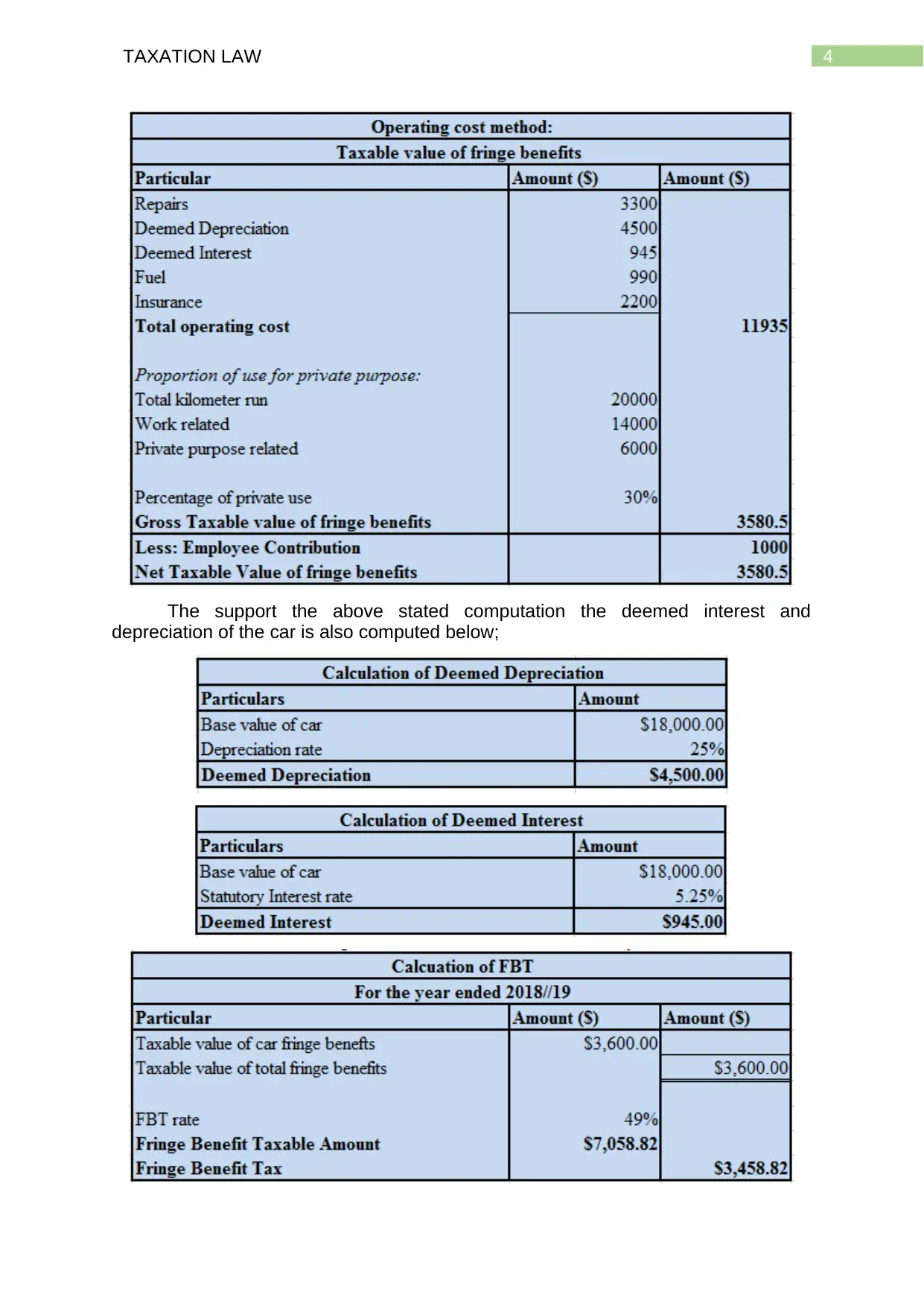
4TAXATION LAW
The support the above stated computation the deemed interest and
depreciation of the car is also computed below;
The support the above stated computation the deemed interest and
depreciation of the car is also computed below;
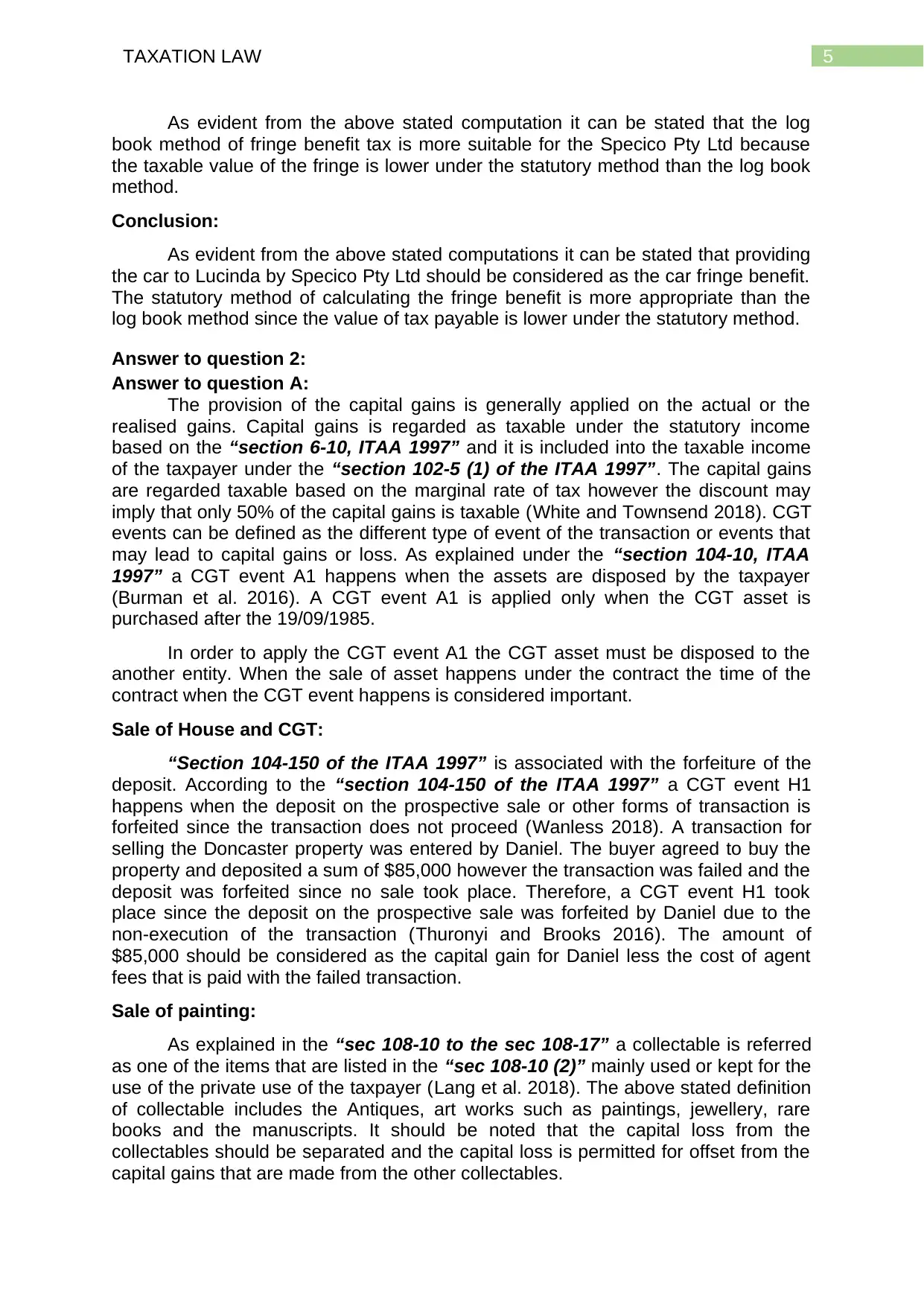
5TAXATION LAW
As evident from the above stated computation it can be stated that the log
book method of fringe benefit tax is more suitable for the Specico Pty Ltd because
the taxable value of the fringe is lower under the statutory method than the log book
method.
Conclusion:
As evident from the above stated computations it can be stated that providing
the car to Lucinda by Specico Pty Ltd should be considered as the car fringe benefit.
The statutory method of calculating the fringe benefit is more appropriate than the
log book method since the value of tax payable is lower under the statutory method.
Answer to question 2:
Answer to question A:
The provision of the capital gains is generally applied on the actual or the
realised gains. Capital gains is regarded as taxable under the statutory income
based on the “section 6-10, ITAA 1997” and it is included into the taxable income
of the taxpayer under the “section 102-5 (1) of the ITAA 1997”. The capital gains
are regarded taxable based on the marginal rate of tax however the discount may
imply that only 50% of the capital gains is taxable (White and Townsend 2018). CGT
events can be defined as the different type of event of the transaction or events that
may lead to capital gains or loss. As explained under the “section 104-10, ITAA
1997” a CGT event A1 happens when the assets are disposed by the taxpayer
(Burman et al. 2016). A CGT event A1 is applied only when the CGT asset is
purchased after the 19/09/1985.
In order to apply the CGT event A1 the CGT asset must be disposed to the
another entity. When the sale of asset happens under the contract the time of the
contract when the CGT event happens is considered important.
Sale of House and CGT:
“Section 104-150 of the ITAA 1997” is associated with the forfeiture of the
deposit. According to the “section 104-150 of the ITAA 1997” a CGT event H1
happens when the deposit on the prospective sale or other forms of transaction is
forfeited since the transaction does not proceed (Wanless 2018). A transaction for
selling the Doncaster property was entered by Daniel. The buyer agreed to buy the
property and deposited a sum of $85,000 however the transaction was failed and the
deposit was forfeited since no sale took place. Therefore, a CGT event H1 took
place since the deposit on the prospective sale was forfeited by Daniel due to the
non-execution of the transaction (Thuronyi and Brooks 2016). The amount of
$85,000 should be considered as the capital gain for Daniel less the cost of agent
fees that is paid with the failed transaction.
Sale of painting:
As explained in the “sec 108-10 to the sec 108-17” a collectable is referred
as one of the items that are listed in the “sec 108-10 (2)” mainly used or kept for the
use of the private use of the taxpayer (Lang et al. 2018). The above stated definition
of collectable includes the Antiques, art works such as paintings, jewellery, rare
books and the manuscripts. It should be noted that the capital loss from the
collectables should be separated and the capital loss is permitted for offset from the
capital gains that are made from the other collectables.
As evident from the above stated computation it can be stated that the log
book method of fringe benefit tax is more suitable for the Specico Pty Ltd because
the taxable value of the fringe is lower under the statutory method than the log book
method.
Conclusion:
As evident from the above stated computations it can be stated that providing
the car to Lucinda by Specico Pty Ltd should be considered as the car fringe benefit.
The statutory method of calculating the fringe benefit is more appropriate than the
log book method since the value of tax payable is lower under the statutory method.
Answer to question 2:
Answer to question A:
The provision of the capital gains is generally applied on the actual or the
realised gains. Capital gains is regarded as taxable under the statutory income
based on the “section 6-10, ITAA 1997” and it is included into the taxable income
of the taxpayer under the “section 102-5 (1) of the ITAA 1997”. The capital gains
are regarded taxable based on the marginal rate of tax however the discount may
imply that only 50% of the capital gains is taxable (White and Townsend 2018). CGT
events can be defined as the different type of event of the transaction or events that
may lead to capital gains or loss. As explained under the “section 104-10, ITAA
1997” a CGT event A1 happens when the assets are disposed by the taxpayer
(Burman et al. 2016). A CGT event A1 is applied only when the CGT asset is
purchased after the 19/09/1985.
In order to apply the CGT event A1 the CGT asset must be disposed to the
another entity. When the sale of asset happens under the contract the time of the
contract when the CGT event happens is considered important.
Sale of House and CGT:
“Section 104-150 of the ITAA 1997” is associated with the forfeiture of the
deposit. According to the “section 104-150 of the ITAA 1997” a CGT event H1
happens when the deposit on the prospective sale or other forms of transaction is
forfeited since the transaction does not proceed (Wanless 2018). A transaction for
selling the Doncaster property was entered by Daniel. The buyer agreed to buy the
property and deposited a sum of $85,000 however the transaction was failed and the
deposit was forfeited since no sale took place. Therefore, a CGT event H1 took
place since the deposit on the prospective sale was forfeited by Daniel due to the
non-execution of the transaction (Thuronyi and Brooks 2016). The amount of
$85,000 should be considered as the capital gain for Daniel less the cost of agent
fees that is paid with the failed transaction.
Sale of painting:
As explained in the “sec 108-10 to the sec 108-17” a collectable is referred
as one of the items that are listed in the “sec 108-10 (2)” mainly used or kept for the
use of the private use of the taxpayer (Lang et al. 2018). The above stated definition
of collectable includes the Antiques, art works such as paintings, jewellery, rare
books and the manuscripts. It should be noted that the capital loss from the
collectables should be separated and the capital loss is permitted for offset from the
capital gains that are made from the other collectables.
⊘ This is a preview!⊘
Do you want full access?
Subscribe today to unlock all pages.

Trusted by 1+ million students worldwide
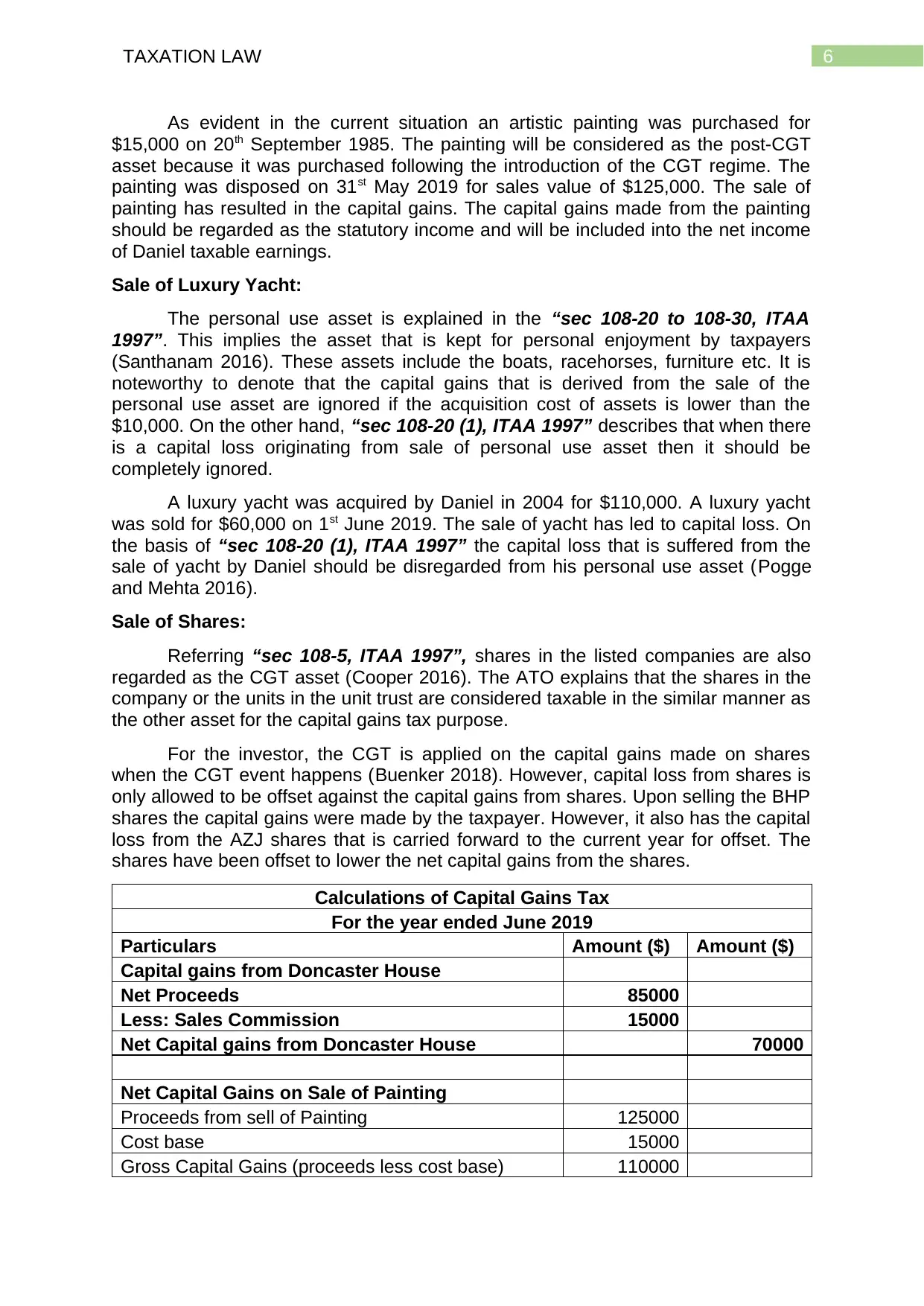
6TAXATION LAW
As evident in the current situation an artistic painting was purchased for
$15,000 on 20th September 1985. The painting will be considered as the post-CGT
asset because it was purchased following the introduction of the CGT regime. The
painting was disposed on 31st May 2019 for sales value of $125,000. The sale of
painting has resulted in the capital gains. The capital gains made from the painting
should be regarded as the statutory income and will be included into the net income
of Daniel taxable earnings.
Sale of Luxury Yacht:
The personal use asset is explained in the “sec 108-20 to 108-30, ITAA
1997”. This implies the asset that is kept for personal enjoyment by taxpayers
(Santhanam 2016). These assets include the boats, racehorses, furniture etc. It is
noteworthy to denote that the capital gains that is derived from the sale of the
personal use asset are ignored if the acquisition cost of assets is lower than the
$10,000. On the other hand, “sec 108-20 (1), ITAA 1997” describes that when there
is a capital loss originating from sale of personal use asset then it should be
completely ignored.
A luxury yacht was acquired by Daniel in 2004 for $110,000. A luxury yacht
was sold for $60,000 on 1st June 2019. The sale of yacht has led to capital loss. On
the basis of “sec 108-20 (1), ITAA 1997” the capital loss that is suffered from the
sale of yacht by Daniel should be disregarded from his personal use asset (Pogge
and Mehta 2016).
Sale of Shares:
Referring “sec 108-5, ITAA 1997”, shares in the listed companies are also
regarded as the CGT asset (Cooper 2016). The ATO explains that the shares in the
company or the units in the unit trust are considered taxable in the similar manner as
the other asset for the capital gains tax purpose.
For the investor, the CGT is applied on the capital gains made on shares
when the CGT event happens (Buenker 2018). However, capital loss from shares is
only allowed to be offset against the capital gains from shares. Upon selling the BHP
shares the capital gains were made by the taxpayer. However, it also has the capital
loss from the AZJ shares that is carried forward to the current year for offset. The
shares have been offset to lower the net capital gains from the shares.
Calculations of Capital Gains Tax
For the year ended June 2019
Particulars Amount ($) Amount ($)
Capital gains from Doncaster House
Net Proceeds 85000
Less: Sales Commission 15000
Net Capital gains from Doncaster House 70000
Net Capital Gains on Sale of Painting
Proceeds from sell of Painting 125000
Cost base 15000
Gross Capital Gains (proceeds less cost base) 110000
As evident in the current situation an artistic painting was purchased for
$15,000 on 20th September 1985. The painting will be considered as the post-CGT
asset because it was purchased following the introduction of the CGT regime. The
painting was disposed on 31st May 2019 for sales value of $125,000. The sale of
painting has resulted in the capital gains. The capital gains made from the painting
should be regarded as the statutory income and will be included into the net income
of Daniel taxable earnings.
Sale of Luxury Yacht:
The personal use asset is explained in the “sec 108-20 to 108-30, ITAA
1997”. This implies the asset that is kept for personal enjoyment by taxpayers
(Santhanam 2016). These assets include the boats, racehorses, furniture etc. It is
noteworthy to denote that the capital gains that is derived from the sale of the
personal use asset are ignored if the acquisition cost of assets is lower than the
$10,000. On the other hand, “sec 108-20 (1), ITAA 1997” describes that when there
is a capital loss originating from sale of personal use asset then it should be
completely ignored.
A luxury yacht was acquired by Daniel in 2004 for $110,000. A luxury yacht
was sold for $60,000 on 1st June 2019. The sale of yacht has led to capital loss. On
the basis of “sec 108-20 (1), ITAA 1997” the capital loss that is suffered from the
sale of yacht by Daniel should be disregarded from his personal use asset (Pogge
and Mehta 2016).
Sale of Shares:
Referring “sec 108-5, ITAA 1997”, shares in the listed companies are also
regarded as the CGT asset (Cooper 2016). The ATO explains that the shares in the
company or the units in the unit trust are considered taxable in the similar manner as
the other asset for the capital gains tax purpose.
For the investor, the CGT is applied on the capital gains made on shares
when the CGT event happens (Buenker 2018). However, capital loss from shares is
only allowed to be offset against the capital gains from shares. Upon selling the BHP
shares the capital gains were made by the taxpayer. However, it also has the capital
loss from the AZJ shares that is carried forward to the current year for offset. The
shares have been offset to lower the net capital gains from the shares.
Calculations of Capital Gains Tax
For the year ended June 2019
Particulars Amount ($) Amount ($)
Capital gains from Doncaster House
Net Proceeds 85000
Less: Sales Commission 15000
Net Capital gains from Doncaster House 70000
Net Capital Gains on Sale of Painting
Proceeds from sell of Painting 125000
Cost base 15000
Gross Capital Gains (proceeds less cost base) 110000
Paraphrase This Document
Need a fresh take? Get an instant paraphrase of this document with our AI Paraphraser
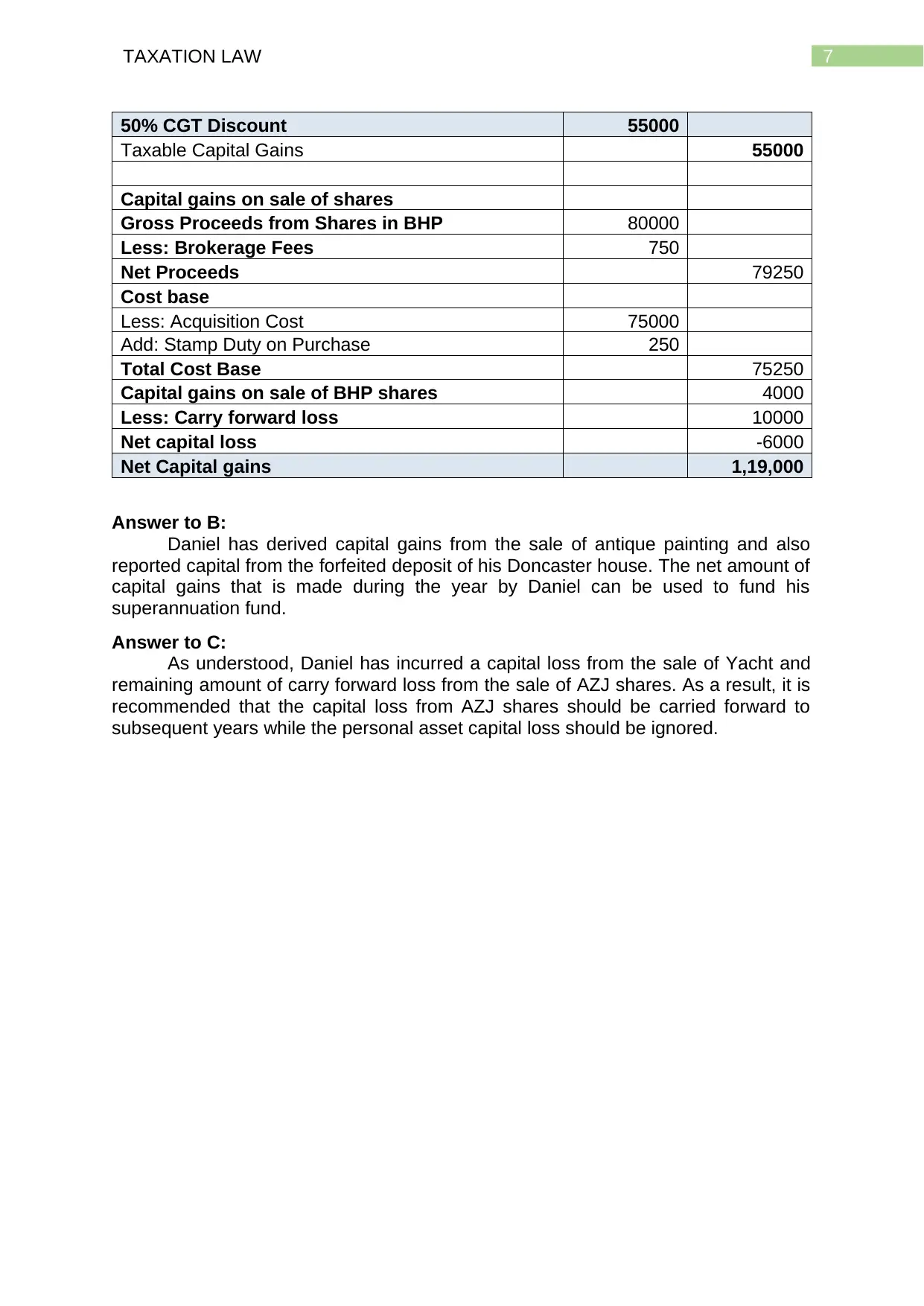
7TAXATION LAW
50% CGT Discount 55000
Taxable Capital Gains 55000
Capital gains on sale of shares
Gross Proceeds from Shares in BHP 80000
Less: Brokerage Fees 750
Net Proceeds 79250
Cost base
Less: Acquisition Cost 75000
Add: Stamp Duty on Purchase 250
Total Cost Base 75250
Capital gains on sale of BHP shares 4000
Less: Carry forward loss 10000
Net capital loss -6000
Net Capital gains 1,19,000
Answer to B:
Daniel has derived capital gains from the sale of antique painting and also
reported capital from the forfeited deposit of his Doncaster house. The net amount of
capital gains that is made during the year by Daniel can be used to fund his
superannuation fund.
Answer to C:
As understood, Daniel has incurred a capital loss from the sale of Yacht and
remaining amount of carry forward loss from the sale of AZJ shares. As a result, it is
recommended that the capital loss from AZJ shares should be carried forward to
subsequent years while the personal asset capital loss should be ignored.
50% CGT Discount 55000
Taxable Capital Gains 55000
Capital gains on sale of shares
Gross Proceeds from Shares in BHP 80000
Less: Brokerage Fees 750
Net Proceeds 79250
Cost base
Less: Acquisition Cost 75000
Add: Stamp Duty on Purchase 250
Total Cost Base 75250
Capital gains on sale of BHP shares 4000
Less: Carry forward loss 10000
Net capital loss -6000
Net Capital gains 1,19,000
Answer to B:
Daniel has derived capital gains from the sale of antique painting and also
reported capital from the forfeited deposit of his Doncaster house. The net amount of
capital gains that is made during the year by Daniel can be used to fund his
superannuation fund.
Answer to C:
As understood, Daniel has incurred a capital loss from the sale of Yacht and
remaining amount of carry forward loss from the sale of AZJ shares. As a result, it is
recommended that the capital loss from AZJ shares should be carried forward to
subsequent years while the personal asset capital loss should be ignored.
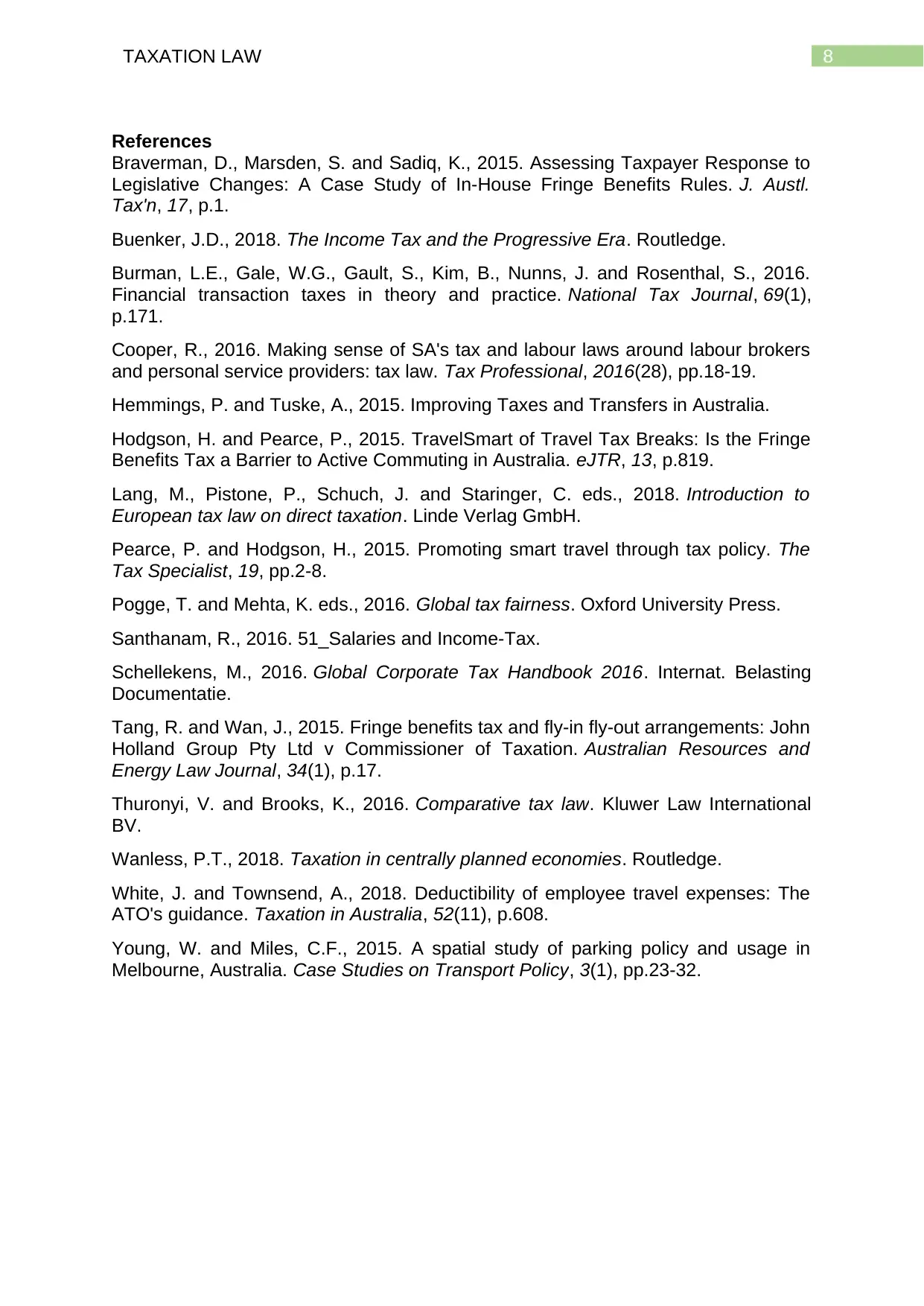
8TAXATION LAW
References
Braverman, D., Marsden, S. and Sadiq, K., 2015. Assessing Taxpayer Response to
Legislative Changes: A Case Study of In-House Fringe Benefits Rules. J. Austl.
Tax'n, 17, p.1.
Buenker, J.D., 2018. The Income Tax and the Progressive Era. Routledge.
Burman, L.E., Gale, W.G., Gault, S., Kim, B., Nunns, J. and Rosenthal, S., 2016.
Financial transaction taxes in theory and practice. National Tax Journal, 69(1),
p.171.
Cooper, R., 2016. Making sense of SA's tax and labour laws around labour brokers
and personal service providers: tax law. Tax Professional, 2016(28), pp.18-19.
Hemmings, P. and Tuske, A., 2015. Improving Taxes and Transfers in Australia.
Hodgson, H. and Pearce, P., 2015. TravelSmart of Travel Tax Breaks: Is the Fringe
Benefits Tax a Barrier to Active Commuting in Australia. eJTR, 13, p.819.
Lang, M., Pistone, P., Schuch, J. and Staringer, C. eds., 2018. Introduction to
European tax law on direct taxation. Linde Verlag GmbH.
Pearce, P. and Hodgson, H., 2015. Promoting smart travel through tax policy. The
Tax Specialist, 19, pp.2-8.
Pogge, T. and Mehta, K. eds., 2016. Global tax fairness. Oxford University Press.
Santhanam, R., 2016. 51_Salaries and Income-Tax.
Schellekens, M., 2016. Global Corporate Tax Handbook 2016. Internat. Belasting
Documentatie.
Tang, R. and Wan, J., 2015. Fringe benefits tax and fly-in fly-out arrangements: John
Holland Group Pty Ltd v Commissioner of Taxation. Australian Resources and
Energy Law Journal, 34(1), p.17.
Thuronyi, V. and Brooks, K., 2016. Comparative tax law. Kluwer Law International
BV.
Wanless, P.T., 2018. Taxation in centrally planned economies. Routledge.
White, J. and Townsend, A., 2018. Deductibility of employee travel expenses: The
ATO's guidance. Taxation in Australia, 52(11), p.608.
Young, W. and Miles, C.F., 2015. A spatial study of parking policy and usage in
Melbourne, Australia. Case Studies on Transport Policy, 3(1), pp.23-32.
References
Braverman, D., Marsden, S. and Sadiq, K., 2015. Assessing Taxpayer Response to
Legislative Changes: A Case Study of In-House Fringe Benefits Rules. J. Austl.
Tax'n, 17, p.1.
Buenker, J.D., 2018. The Income Tax and the Progressive Era. Routledge.
Burman, L.E., Gale, W.G., Gault, S., Kim, B., Nunns, J. and Rosenthal, S., 2016.
Financial transaction taxes in theory and practice. National Tax Journal, 69(1),
p.171.
Cooper, R., 2016. Making sense of SA's tax and labour laws around labour brokers
and personal service providers: tax law. Tax Professional, 2016(28), pp.18-19.
Hemmings, P. and Tuske, A., 2015. Improving Taxes and Transfers in Australia.
Hodgson, H. and Pearce, P., 2015. TravelSmart of Travel Tax Breaks: Is the Fringe
Benefits Tax a Barrier to Active Commuting in Australia. eJTR, 13, p.819.
Lang, M., Pistone, P., Schuch, J. and Staringer, C. eds., 2018. Introduction to
European tax law on direct taxation. Linde Verlag GmbH.
Pearce, P. and Hodgson, H., 2015. Promoting smart travel through tax policy. The
Tax Specialist, 19, pp.2-8.
Pogge, T. and Mehta, K. eds., 2016. Global tax fairness. Oxford University Press.
Santhanam, R., 2016. 51_Salaries and Income-Tax.
Schellekens, M., 2016. Global Corporate Tax Handbook 2016. Internat. Belasting
Documentatie.
Tang, R. and Wan, J., 2015. Fringe benefits tax and fly-in fly-out arrangements: John
Holland Group Pty Ltd v Commissioner of Taxation. Australian Resources and
Energy Law Journal, 34(1), p.17.
Thuronyi, V. and Brooks, K., 2016. Comparative tax law. Kluwer Law International
BV.
Wanless, P.T., 2018. Taxation in centrally planned economies. Routledge.
White, J. and Townsend, A., 2018. Deductibility of employee travel expenses: The
ATO's guidance. Taxation in Australia, 52(11), p.608.
Young, W. and Miles, C.F., 2015. A spatial study of parking policy and usage in
Melbourne, Australia. Case Studies on Transport Policy, 3(1), pp.23-32.
⊘ This is a preview!⊘
Do you want full access?
Subscribe today to unlock all pages.

Trusted by 1+ million students worldwide
1 out of 9
Related Documents
Your All-in-One AI-Powered Toolkit for Academic Success.
+13062052269
info@desklib.com
Available 24*7 on WhatsApp / Email
![[object Object]](/_next/static/media/star-bottom.7253800d.svg)
Unlock your academic potential
Copyright © 2020–2026 A2Z Services. All Rights Reserved. Developed and managed by ZUCOL.





